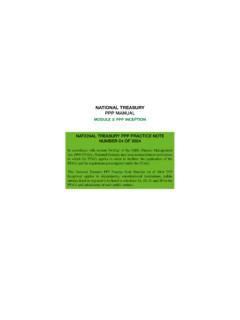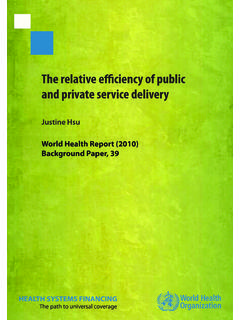Transcription of Introducing Public Private Partnerships in South …
1 Introducing Public Private Partnerships in South AfricaSince 1999, Public Private Partnerships (PPPs) in South Africa have been regulated under the PFMA, providing a clear and transparent framework for government and its Private sector partners to enter into mutually beneficial commercial transactions, for the Public good. Over the past seven years, we have progressively increased the number of PPP transactions covering a wide range of sectors, including transport, office accommodation, healthcare, eco-tourism, social development and correctional services. By 2007, there were 20 PPP projects in active implementation with no fewer than six projects reaching financial close during 2006 increased number of projects attests to the growing body of experience related to PPPs, both within government and across the Private sector.
2 There have been some key lessons over the years, and some of these are captured in this document. It has taken repeated interactions between government institutions and the Private sector to better understand each other s needs. Ultimately, the objective of good PPP projects is to achieve win-win outcomes are best achieved when government institutions have a very clear idea of what type of infrastructure and services are required to meet the needs of the Public in a given sector. By communicating these needs precisely to the market, Private sector players can come together in consortia that offer the best mix of skills to devise creative solutions through cost-effective PPPs are but one avenue for procuring capital projects, the process followed is characterised by diligent planning and transparent bidding features that should be encouraged for all procurement methods.
3 Moreover, the pressing service delivery challenges across all spheres of government suggest that PPPs could play an even greater role in South Africa. This publication makes a strong case for stepping up the application of PPPs in those sectors that lend themselves to Private sector participation through effective risk A. Manuel, MP Minister of Finance October 2007minister s foreword1. What are PPPs? 42. Why do we use PPPs? 103. PPPs and BEE 154. The PPP process 185. What makes a good PPP? 226. A snapshot of some South african PPPs 24 Contents441. What are PPPs?Traditional procurement vs PPPsPPPs or Public Private Partnerships are long-term contracts between the Public and Private sector. The main objective of PPPs all over the world is to ensure the delivery of well maintained, cost-effective Public infrastructure or services, by leveraging Private sector expertise and transferring risk to the Private sector.
4 In traditional procurement of Public services or infrastructure, government pays for capital and operating costs and carries the risks associated with cost overruns and late delivery. While the expertise and experience of a Private company may be procured for the design and construction of infrastructure, once the asset is delivered the Private company is paid and then leaves. The Public sector is then responsible for staffing, maintenance, and operation. In PPP procurement on the other hand, the Public sector buys a full set of services, including infrastructure and other services, from the Private sector. It pays for these over the term of the PPP agreement, based on successful delivery. The Private sector typically puts its own capital at risk, funding its investment in the project with debt and shareholder equity.
5 Because of the financial risk the Private sector takes, it is motivated to provide a high level of service, as good returns on equity will depend on the quality of services it delivers. Some PPPs, where fees are generated on a user-pay basis, derive income from which government departments or municipalities can share benefits. PPPs are also a good vehicle for other social objectives, such as economic empowerment, through aligning the incentives of the Private party with those are PPPs?Some definitions of PPPsInternationally: ..A PPP is any medium to long-term relationship between the Public and Private sectors, involving the sharing of risks and rewards of multisector skills, expertise and finance to deliver desired policy outcomes.
6 (Standard & Poor) PPPs are long-term Partnerships to deliver assets and services underpinning Public services and community outcomes. Optimal structuring links Private sector profitability to sustained performance over the long term, yielding robust and attractive cash flows for investors in return for delivering better value for money for the taxpayer. (John Laing plc)A PPP is defined in South african law as:A contract between a government institution and Private party, where:the Private party performs an institutional function and/or uses state property in terms of output specificationssubstantial project risk (financial, technical, operational) is transferred to the Private partythe Private party benefits through: unitary payments from government budgets and/or user basic tests for PPPsThere are three internationally applied standard tests to determine whether a PPP is the appropriate vehicle for procuring a Public asset or service: Can substantial risk be transferred to the Private sector?
7 Is the project affordable to the procuring institution? Does a PPP procurement option show value for money? 6 What are PPPs?6 RiskThe Public sector does not always manage risk well. For example, if an institution is building infrastructure, construction may be completed late and budgets may be overspent. This is not in the Public interest. A key characteristic of PPPs is the transfer of risk from the Public sector to the Private sector. If the Private sector does not complete construction on time and within budget, it will not be paid by the procuring institution. This principle also applies to the provision of services. If the agreed upon services are not available or do not meet the agreed upon standards, the Private party faces financial penalties.
8 However, it is important to understand that the institution does not transfer all the risks to the Private sector. Only those risks that the Private party is best able to manage are of the most important tests for a PPP is whether the procuring institution can afford it, given its available , institutions have not budgeted adequately for their infrastructure and service delivery needs. Budgets may need to be reviewed once proper business cases have been prepared and evaluated. Value for moneyTo decide whether or not to procure infrastructure through a normal tender process or through a PPP, a value-for-money test needs to be applied. How much will it cost for the institution to provide infrastructure and services itself compared to the costs of providing the same infrastructure and services through a PPP?
9 If the comparison shows that a PPP is more cost-effective, the difference in cost between the two scenarios is known as value for money. If the value-for-money test shows that the traditional procurement method is more cost-effective, the PPP option will not be pursued. Characteristics of PPPsA PPP is a clearly defined project, where the procuring institution carefully defines its objectives. The contractual relationship spans a set length of time, which may range from 5 to 30 years. 77 What are PPPs?The Private party plays a key role at each stage of the project: funding, development, design, completion and implementation. The funding structures of a PPP sometimes combine Public and Private funds. Payment arrangements in PPPs are based on outputs, related to the provision of services and/or infrastructure and services.
10 PPPs are not a way of avoiding payment for capital projects. They allow the procuring institution to spread payments for large projects over the project s lifetime. Direct user charges, like road tolls or water fees, may also contribute to a project s revenue. Risks are allocated to the party most able to carry them. This means mitigating their impact and/or being able to absorb the consequences. Fixed and operational assets are adequately maintained over the project s lifetime. A PPP is not:The way that a PPP is defined in Treasury Regulation 16 makes it clear that:A PPP is not a simple outsourcing of functions - it is a long-term contract involving substantial risk transfer A PPP is not a donation by a Private party for a Public PPP is not the privatisation of state assets and/or in South AfricaThe government of South Africa is committed to delivering quality infrastructure and related services in line with its commitment to ensuring a better life for all.












